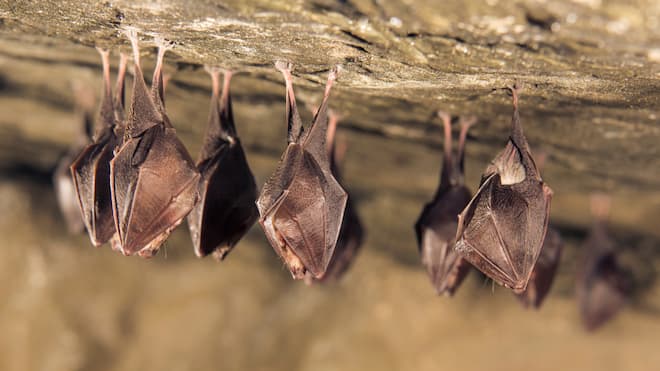There are in total eight species of bats in Ontario. From those eight The Little Brown Myotis, Least or Small-footed Bat, Eastern Pipistrelle, and the Big Brown Bat hibernate in the winter. When food runs out in the fall, these four bats will go in search of cool and humid mines and or caves. When these bats are in these areas, they enter a stage called torpor which allows them to drop their body temperature to that of the space they’re in. There are a few species in Ontario that only pass their summers over here. These bats are the Red Bat, Silver-haired Bat, and the Hoary Bat. These three bats avoid the cold temperatures by immigrating south in the winters. There seems to be a growing concern for their survival because bats hibernate in small enclosed areas.
If you notice a bat presence or hear noises in your attic or around your property, contact the specialists from Bat Control.
Bats have an interesting way of hibernating and to them this all through teamwork. Bats in nature scoot together and create heat from their bodies that emanate. Bats prefer dark and secluded areas that include but are not limited to caverns, caves, mines, barns, and hollow trees. Bats mostly hibernate between April and October. When they emerge from their hibernation, they usually feast on insects since bats are insectivores. They can feast on mosquitoes, spiders, moths, and other insects. They play a very important part in the ecosystem that can prevent the overpopulation of certain insect species. Their guano is also said and proven to be a very effective fertilizer. This makes bats an indispensable part of the overall ecosystem.
So, what happens if a bat does find your attic and decides to stay? Due to their protected status, they can’t be just chased out or lead out. Technicians are bound by law to wait and to act when it is allowed… The best time to remove bats is somewhere between spring when they return to the roost and are out of hibernation and in the fall before they go back to their roost. This is a good time because technicians can also make sure that no young are in the attic. Bats give birth in late May and June. Baby bats are completely helpless and will always need their mother. Bat pups will leave the roost approximately 2-3 months after giving birth.
Professionals are the only qualified people that can get a bat out of the house through tested and proven techniques that have been working time and time again. They scour the perimeter of the roof in search of openings that the bats have used or still can use to get inside the house. They note this and seal it. Most bats use one entry point, this entry point will be used to get the bat out with the help of a clever device called the Bat Cone. The bat cone is a cone-like device, that allows the bat to exit the property, but not re-enter. They are angled downwards to make sure; they can’t find a way to get in. Once out, the entry point gets sealed.
